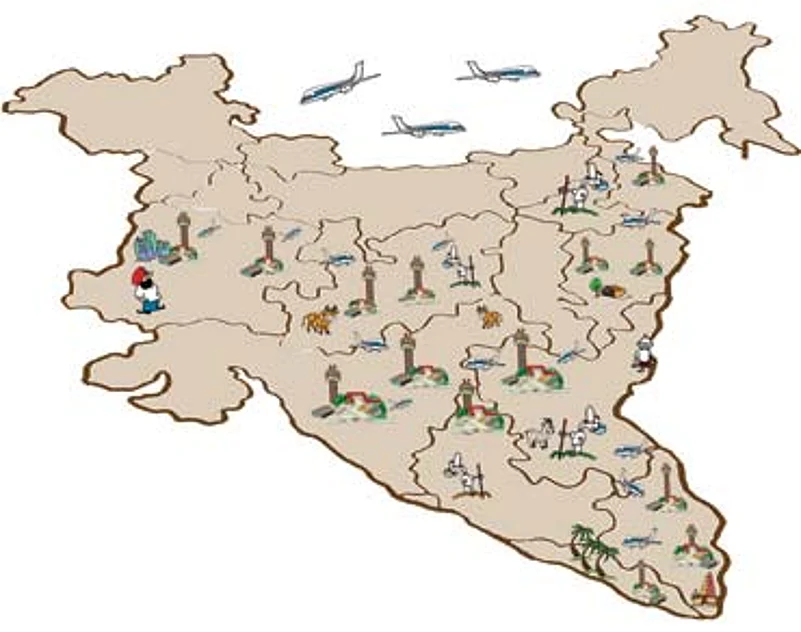***
Seeking Landing Rights: Proposed sites for low-cost airports
Maharashtra - Kolhapur, Latur, Yavatmal, Ratnagiri, Nanded, Osmanabad, Sholapur, Karad, Sangli, Amravati, Gondia, Baramati, Shirdi, Jalgaon, Solapur, Akola
Karnataka - Shimoga, Gulbarga, Hassan, Bijapur, Bellary, Karwar
Andhra Pradesh - Nellore, Kadapa/Ongole, Ramagundam, Tadepalligudem
Tamil Nadu - Tuticorin, Sriperumbudur
Kerala - Kannur
Rajasthan - Ajmer, Mount Abu
West Bengal - Kanchrapara, Barrackpore, Durgapur
Orissa - Jharsuguda
Punjab Ludhiana, Patiala
***

Driven by immense real estate opportunities and estimates that air passenger traffic in smaller towns will grow by at least 20 per cent a year until 2012, airport developers have been getting into the act. The Tata Group has tied up with Singapore's Changi, while German Fraport AG has joined hands with dlf. Other interested firms include the Anil Ambani-promoted Reliance Energy and infrastructure majors GMR, GVK, L&T and the Raheja Group. "These low-cost airports will encourage economic activity in small districts and towns, help in decongesting the metro airports and also give an impetus to regional airlines," says Union minister for civil aviation Praful Patel.
Globally, of course, such airports provide alternatives to the major hub airports and are used by low-cost carriers flying smaller aircraft. "These airports have to be more convenient and cheaper for its users. It has just an airstrip, a basic terminal building with air traffic control and night-landing facilities. A typical low-cost airport with no frills can be built for Rs 40-50 crore," says Captain Gopinath, MD, Air Deccan, a member of the GVK, Raheja and IDFC consortium that is looking at cities in Andhra as possible destinations.
A more liberal public-private model for such airports is being put in place. A new policy on greenfield airports, recently submitted to the cabinet for approval, allows state governments to set up such airports by themselves or through any designated entity or a joint venture company. "These airports are expected to allow up to 100 per cent foreign ownership where investors could even be foreign airport companies or airlines,'' says Patel.
What about the business model, considering these airports may not attract much traffic initially? Says aviation expert Kapil Kaul from the Centre for Asia Pacific Aviation, "The central and state governments have to offer some incentives like straight cash injections, underwriting a certain amount of seats on various airlines, discounting aviation turbine fuel (ATF) taxes etc at least till such time as traffic numbers stabilise in these remote cities." Apart from fiscal concessions, states are granting land and real estate development rights. Adds Gopinath: "Along with the airports, one needs to build technology parks and special economic zones so that the money invested in the airport construction and running can be recovered by other real estate developments."
On the ground, there's already one example. Karnataka recently awarded Maytas Infra, a Hyderabad-based private infrastructure firm, the rights to build and develop airports in Shimoga and Gulbarga on the PPP model. Says P.V. Ravi, MD and ceo, Infrastructure Development Corporation, Karnataka, "The government will enter into an agreement with the private company for a 30-year lease for both these airports where it will not partner as a stakeholder but more as a governing body." Maytas will set up real estate infrastructure as mandated by the AAI, but only after it completes the airport and no extra land would be released.
Maharashtra has decided to hand over 16 small airports and airstrips in the state to private parties for development. "We will offer huge real estate opportunities to set up IT parks, flying clubs etc and offer discounted ATF," says R.C. Sinha, MD, Maharashtra Airport Development Corporation. Apart from Amravati, Maharashtra is also looking at developing basic airports at cities like Yavatmal and Ratnagiri. In the same vein,
R. Ramasundaram, chairman, Tamil Nadu Investment Development Corporation, says, "There is a large scope of connecting manufacturing hubs Sriperumbudur and Tuticorin. Especially as there is demand given that all domestic airlines have exponentially increased their flights to other existing non-metro airports like Trichy and Coimbatore."
Andhra too is in conversation with Captain Gopinath. Says he: "An Air Deccan team has already spoken to the Andhra government and the state is keen on building low-cost airports near Adilabad, Nellur and Khammam and so on." Kerala is also planning to develop the Kannur airport on the lines of the Cochin International Airport Ltd (CIAL), India's first privately owned airport. Says A.C.K. Nair, airport director, CIAL, "We have been approached by various state governments and private consortiums to partner and build low-cost airports across the country. But, instead of going through a bidding process, we would like to be preferential invitees." Other states like West Bengal, Madhya Pradesh are also getting into the act.
Where's the catch? The biggest challenge for any airport investor involved in such projects will be generating high levels of non-aeronautical revenues that will require additional land. Says Sanjay Reddy, MD, GVK (the group that is modernising the Mumbai airport), "We reconsidered our earlier decision to build low-cost airports in Bijapur, Shimoga and Gulbarga as we were not convinced about the land availability and the kind of connectivity airlines can achieve in these cities." As most state governments are granting land to private airport operators for various other development projects, it's obvious that land development will drive revenues. Says a leading player: "Airport development in the larger context has to be a real estate game where the real money is in building non-aeronautical infrastructure."
Another worry is that the low-cost carriers, the primary audience for such airports, have been lukewarm. Says Ajay Singh, director, Spice Jet: "We are only interested in the metros. Given that these airports might bring in more traffic to the major airports, it might be good for us. But we are not looking at flying to these airports.'' Adds Jeh Wadia, MD, Go Air: "If low-cost airports bring down the costs, nothing like it. But there's nothing on the cards as yet.''
As the impact of the Indian aviation juggernaut reaches the smaller towns, the travel demand will increase. But that's still some time away. As Patel puts it, "Initially these airports will not make money so state governments will have to ensure additional real estate opportunities to lure private developers." Clearly, for now, it's as much about land as it is about sky.






















